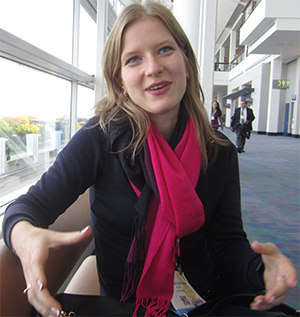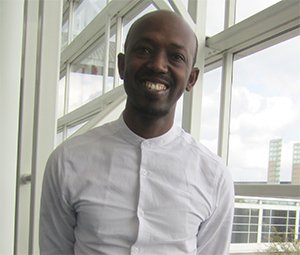Ophthalmologists in the United States may perform or assist up to 500 procedures during residency (minimum 200), but in some countries, they do no surgeries at all.1 For ophthalmologists like Olena Hurzhii, MD, of Ukraine, training gaps like these present a challenge — one that she and other doctors meet in part by turning to the global community of ophthalmologists.

Dr. Hurzhii
Dr. Hurzhii completed a six-year medical degree and two-year residency in Ukraine, but neither program gave her surgical experience. To remedy some of the gaps in her training, Dr. Hurzhii looked beyond eastern Europe in a journey that led first to Saudi Arabia, then eventually the Academy’s Rotary Club Host Program. While she didn't get surgical experience, she did find a community that helps her continue to grow as a physician and do more for her patients.
She started by requesting a mentor through an online program coordinated by Ophthalmic Women Leaders. After they matched her with a hospital administrator in Saudi Arabia, the two women made a plan to address some of Dr. Hurzhii’s challenges. Eventually, Dr. Hurzhii’s mentor connected her to Michael Brennan, MD, a past Academy president who now serves as the Academy’s international envoy.
With Dr. Brennan’s help, Dr. Hurzhii began a series of month-long observerships in Portugal, Denmark and Ireland. Because of local certification and licensure requirements, observerships do not offer the chance to operate on patients. However, Dr. Hurzhii said the experiences showed her that other countries’ medical education does include “hands-on experience.”
Her time abroad revealed other possibilities, too. “It helped me to understand that if there are no ways to do something in your own country, there are ways” to do it in other countries, she said.
Eventually, Dr. Hurzhii applied for the Academy’s Rotary Club Host Program, which brought her to the United States in 2015. Under the program, primarily run by Academy past-president Kenneth D. Tuck, MD, ophthalmologists from eligible countries spend one to two weeks visiting a U.S. host ophthalmologist, observing daily practice in his or her office, and one week attending the Academy’s annual meeting.
As a long-time Rotary participant, it was natural for Dr. Brennan to host Dr. Hurzhii in 2015, housing her at his home in North Carolina and providing one week’s observation of his practice at Alamance Eye Center. “Helen [his wife] and I do it just because we love the kids so much,” Dr. Brennan said of the Rotary program (he has several adult children, to whom he’s effectively added his Rotary guests).
Both Drs. Brennan and Tuck said the program often yields near-familial bonds. One of Dr. Tuck’s past guests calls his wife “Mom,” he said. “It’s like family. … If it ends when they go home, we’ve failed.”
Dr. Hurzhii said those relationships provide an international support network she turns to throughout the year. Her mentors abroad “answer all my questions” she said. The doctor she worked with in Denmark even sent her a computer with scans to give her more scientific experience. “This one mentorship program could change my career,” she said.

Dr. Nyemazi
Alex Nyemazi, MD, a 2016 Rotary participant from Rwanda shared a similar sentiment. “Having a week to observe this is a life-changing opportunity,” he said.
For Dr. Nyemazi, a government-employed ophthalmologist who works in a military hospital and teaches at the university, the program gave him new perspective. “Having a week to observe [ophthalmic practice in a U.S. setting] is a life-changing opportunity,” he said. Dr. Tuck hosted Dr. Nyemazi.
In his teaching, Dr. Nyemazi hopes to implement the more collegial approach he observed at Dr. Tuck’s private practice in Roanoke, Va., and during a visit to Wake Forest University’s public clinic. “I found it so fun,” he said of the discussion-centered format. In contrast to the more hierarchical, lecture-driven approach common in Rwanda, he thought roundtables would improve the classroom experience. “I think my students would learn more.”
Observing the physician-patient relationship also gave Dr. Nyemazi new ideas for how to approach his clinic time. “Back home there is a big gap” between doctor and patient, he said. “They are so far apart from each other.”
He said he also wanted to address gaps between various workers at the hospital, who don’t always see themselves as part of a team or think about how their work connects to what others do for patients.
But perhaps the biggest change in mindset affected Dr. Nyemazi’s approach to rural patients, he said. As part of his work for the hospital, he spends one week a month doing eye checks and surgeries in rural areas. Because of Rwanda’s geography — what he called a “country of a thousand hills” — and the limited roads, Dr. Nyemazi said some patients are a 30-mile hike or more from roads to the country’s medical facilities.
“These patients are lying in those villages and they are blind, and they need someone. Who is this person who’s going to come to them? It’s me.”
He said he’s already doing that, but that “I’m inspired by this meeting to do it more. The fact that Rotary had me here, spent all that money on me — you guys don’t know me.” For him, the proper response to such generosity was to give even more to his neediest patients.
As young leaders like Dr. Nyemazi and Hurzhii leverage the global community of ophthalmologists, they help not just their patients but the next generation of physicians. Since her involvement in Rotary, Dr. Hurzhii has started a journal club for other ophthalmologists. Dr. Nyemazi chairs Rwanda’s young ophthalmology forum and serves with the College of Ophthalmology of Eastern Central and Southern Africa, which helps train the next generation of English-speaking physicians in sub-Saharan Africa.
Since 2000, more than 100 ophthalmologists like Drs. Nyemazi and Hurzhii have visited U.S. ophthalmologists and attended the Academy annual meeting through the Rotary Club Host Project. The Academy’s Global Alliances Secretariat and Annamarie Hastings administer the program in coordination with nearly 30 Rotary Clubs around the country. For more information about the Academy’s Rotary Host Project, email ahastings@aao.org
1 The Accreditation Council for Graduate Medical Education requires U.S. residency programs to have ophthalmology trainees assist or perform at least 200 procedures. ACGME data for 2016 shows the median number of procedures performed or assisted is actually much higher: 496.
* * *
About the author: Christi A. Foist is YO Info’s managing editor and a communications manager for the Academy.
Save